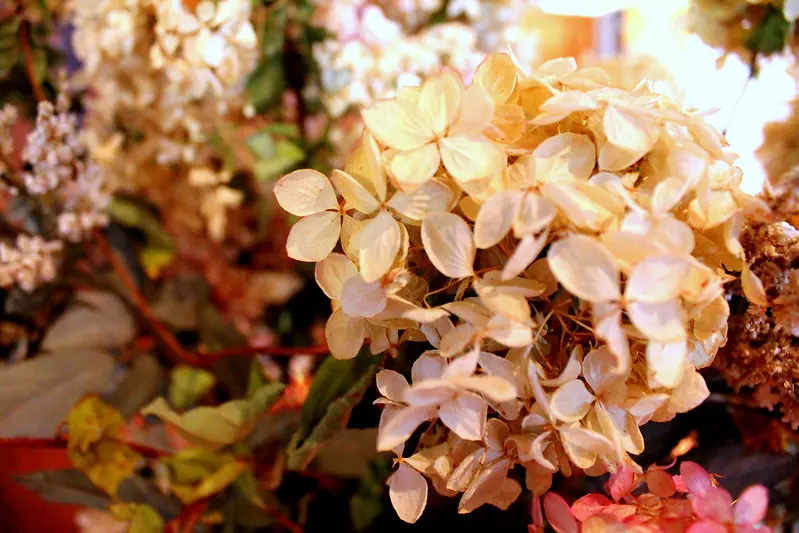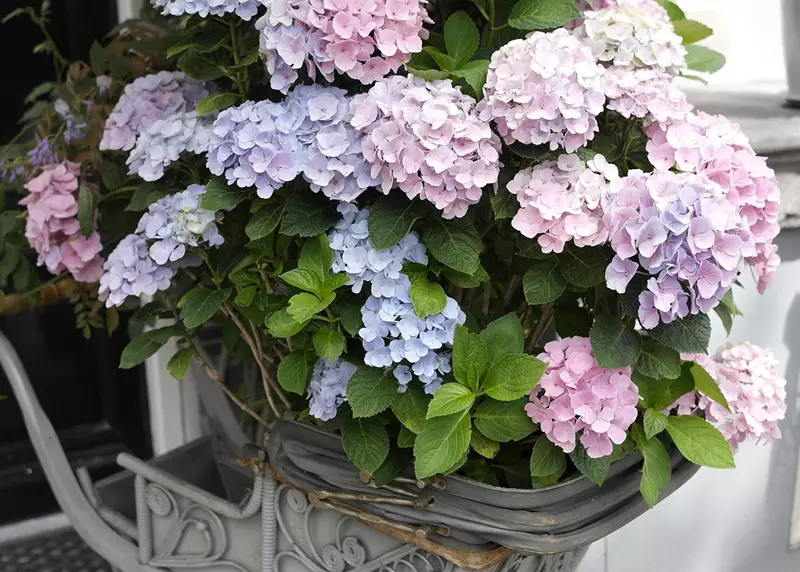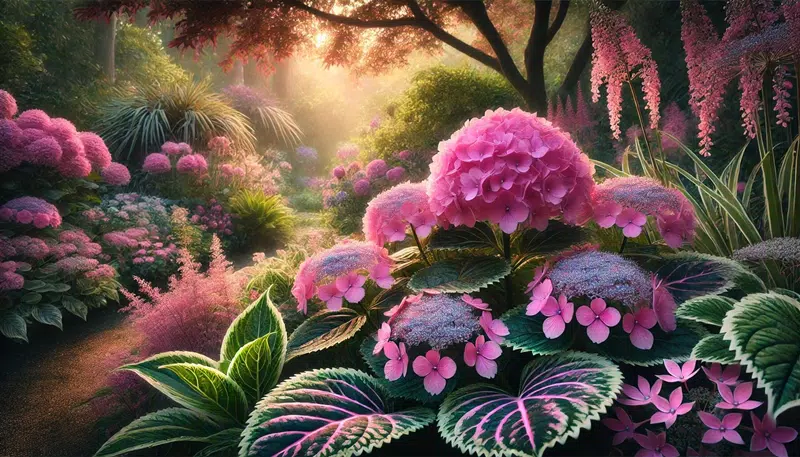Table of Contents
Materials Needed for Crafting a Hydrangea Bouquet
Creating a stunning hydrangea bouquet requires careful selection of materials to ensure a harmonious and long-lasting arrangement. Below is a comprehensive list of essential items, along with detailed explanations to guide you in assembling your bouquet.
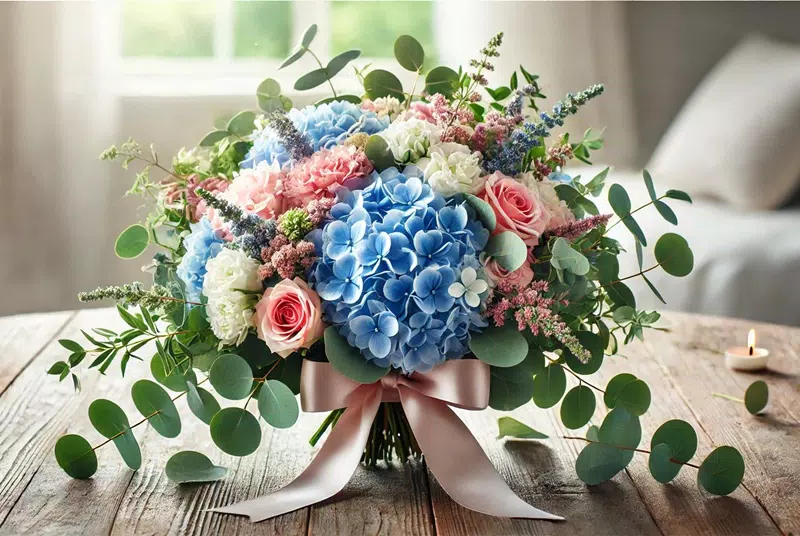 Source: hydrangealibrary.com; Author: AI
Source: hydrangealibrary.com; Author: AI
1. Fresh Hydrangea Stems
Hydrangeas serve as the focal point of your bouquet, offering lush and voluminous blooms. When selecting hydrangea stems, choose blooms that are vibrant and free from blemishes. The number of stems needed depends on the desired fullness of the bouquet; typically, 3 to 5 stems create a substantial arrangement.
2. Complementary Flowers
To add variety and texture, incorporate complementary flowers such as:
- Roses: Introduce elegance and a contrasting shape.
- Baby's Breath (Gypsophila): Provides a delicate, airy feel.
- Lisianthus: Offers a soft, romantic touch.
Choose flowers that harmonise in colour and size with the hydrangeas to maintain a cohesive look.
3. Greenery
Greenery adds depth and frames the bouquet. Suitable options include:
- Eucalyptus: Features aromatic, silvery leaves.
- Ferns: Introduce a feathery texture.
- Ruscus: Provides sturdy, glossy foliage.
Incorporating greenery enhances the bouquet's visual interest and structure.
4. Sharp Floral Scissors or Knife
Using sharp tools ensures clean cuts on the stems, which is crucial for optimal water absorption and the longevity of the flowers. Avoid using dull instruments, as they can crush the stems and impede hydration.
5. Floral Tape
Floral tape is essential for binding the stems securely. It is flexible and adheres to itself, providing a neat and professional finish. Ensure you use green or a colour that matches the stems for a seamless appearance.
6. Decorative Ribbon
A decorative ribbon conceals the floral tape and adds an aesthetic touch to the bouquet handle. Choose a ribbon that complements the colour scheme of the bouquet. Satin or grosgrain ribbons are popular choices for their texture and sheen.
7. Corsage Pins
Corsage pins are used to secure the ribbon in place. Opt for pins with decorative heads for added elegance. Ensure they are inserted carefully to avoid damaging the stems.
8. Clean Vase with Fresh Water
After assembling the bouquet, placing it in a clean vase filled with fresh water keeps the flowers hydrated and prolongs their freshness. Ensure the vase is appropriately sized to support the bouquet without causing overcrowding.
By meticulously selecting and preparing these materials, you can craft a hydrangea bouquet that is both beautiful and enduring, suitable for various occasions.
Preparing Hydrangeas for Your Bouquet
Ensuring the longevity and vibrancy of hydrangeas in your bouquet requires meticulous preparation. By following these detailed steps, you can maintain the freshness of these blooms and create a stunning arrangement.
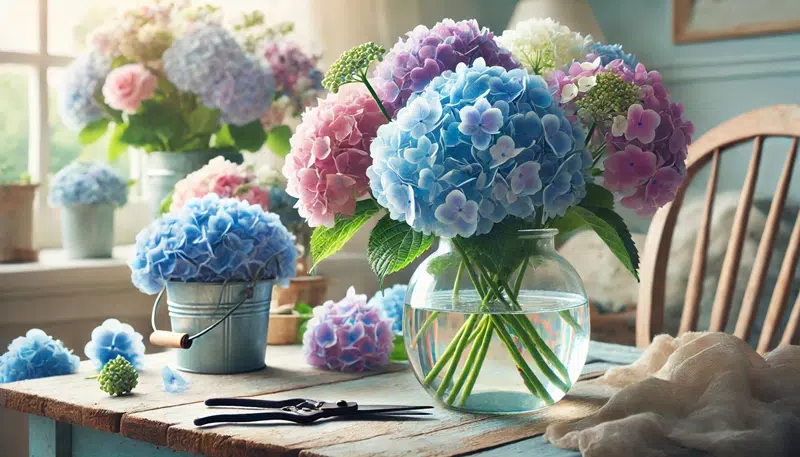 Source: hydrangealibrary.com; Author: AI
Source: hydrangealibrary.com; Author: AI
1. Selecting the Right Hydrangea Blooms
Choose mature hydrangea flowers that are fully open, as they are more resilient and last longer when cut. Avoid selecting blooms that are still developing, as they may not open properly once cut.
2. Optimal Cutting Time
Harvest hydrangea stems during the early morning or late afternoon when temperatures are cooler. This timing ensures the plants are well-hydrated, reducing the risk of wilting.
3. Proper Cutting Technique
Use sharp, clean floral scissors or a knife to cut the stems at a 45-degree angle. This angled cut increases the surface area for water absorption, promoting hydration.
4. Immediate Post-Harvest Care
After cutting, promptly place the hydrangea stems in a bucket of lukewarm water. This practice prevents air from entering the stems, which can cause blockages and impede water uptake.
5. Removing Excess Foliage
Strip any leaves from the lower portion of the stems that will be submerged in water. This step prevents bacterial growth in the vase, which can shorten the lifespan of the flowers.
6. Conditioning the Stems
To enhance water uptake, immerse the hydrangea stems in a bucket of water up to their necks and let them hydrate for several hours or overnight before arranging.
7. Hydration Enhancement Techniques
For hydrangeas prone to wilting, consider the following methods:
- Hot Water Treatment: Dip the bottom 2 inches of the stems in hot water (approximately 43°C) for 30 seconds, then transfer them to cool water. This technique helps eliminate air bubbles that can block water uptake.
- Alum Dipping: After cutting the stems, dip the ends into alum powder before placing them in water. This method can improve water absorption and prolong freshness.
8. Maintaining Hydrangea Freshness in the Arrangement
Once arranged, place the bouquet in a clean vase filled with fresh, cool water. Change the water daily and re-cut the stems every few days to maintain optimal hydration. Keep the arrangement in a cool environment, away from direct sunlight and heat sources, to prolong the life of the hydrangeas.
By diligently following these preparation steps, your hydrangea bouquet will remain vibrant and beautiful, enhancing any setting with its lush blooms.
Arranging the Bouquet
Crafting a stunning hydrangea bouquet involves thoughtful selection and placement of each element to achieve a harmonious and visually appealing arrangement. By following these detailed steps, you can create a bouquet that showcases the beauty of hydrangeas complemented by other flowers and greenery.
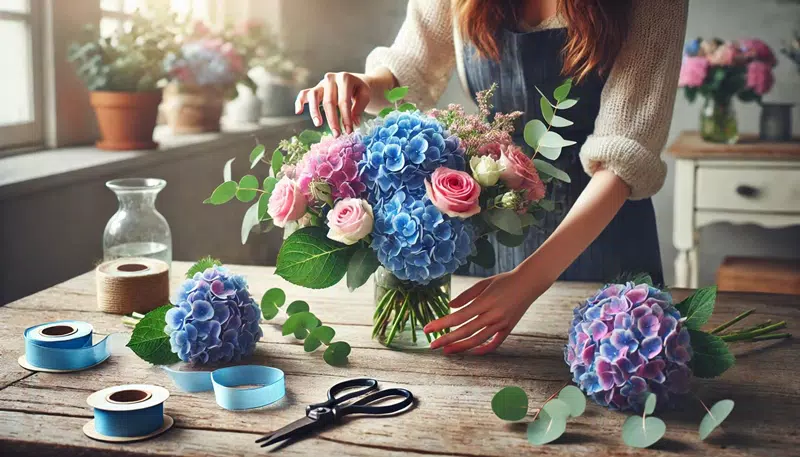 Source: hydrangealibrary.com; Author: AI
Source: hydrangealibrary.com; Author: AI
1. Gather Your Materials
Ensure you have all necessary materials prepared, including:
- Freshly cut hydrangea stems
- Complementary flowers (e.g., roses, lisianthus)
- Greenery (e.g., eucalyptus, ferns)
- Floral tape
- Decorative ribbon
- Sharp floral scissors or knife
- Clean vase with fresh water
2. Prepare the Flowers and Greenery
Before arranging, remove any leaves from the lower portions of the stems that will be submerged in water to prevent bacterial growth. Trim each stem at a 45-degree angle to facilitate better water absorption. For hydrangeas, consider dipping the stem ends in alum powder to enhance water uptake and maintain freshness.
3. Create the Bouquet Structure
Begin by selecting a central hydrangea stem as the focal point. Gradually add surrounding flowers and greenery, positioning them at slight angles to form a dome shape. Rotate the bouquet as you add each element to ensure even distribution and a balanced appearance.
4. Secure the Arrangement
Once satisfied with the composition, use floral tape to bind the stems together just below the blooms. Ensure the tape is tight enough to hold the flowers in place but not so tight as to damage the stems.
5. Trim the Stems
After securing the bouquet, trim the stems to a uniform length, appropriate for the chosen vase or for handheld presentation. Maintain the 45-degree angle cuts to promote optimal water absorption.
6. Add Decorative Ribbon
Wrap a decorative ribbon around the floral tape to conceal it and enhance the bouquet's aesthetic. Secure the ribbon with a neat bow or use corsage pins for a polished finish.
7. Hydrate the Bouquet
Place the arranged bouquet in a clean vase filled with fresh, cool water. Position the vase in a cool environment, away from direct sunlight and heat sources, to prolong the life of the flowers. Change the water daily and re-cut the stems every few days to maintain freshness.
By meticulously following these steps, you can create a hydrangea bouquet that is both beautiful and enduring, suitable for various occasions.
Securing and Finishing Hydrangea Bouquet
Creating a stunning hydrangea bouquet involves not only arranging the flowers but also properly securing and finishing the bouquet to ensure durability and aesthetic appeal. This guide provides detailed steps to achieve a professional finish for your hydrangea bouquet.
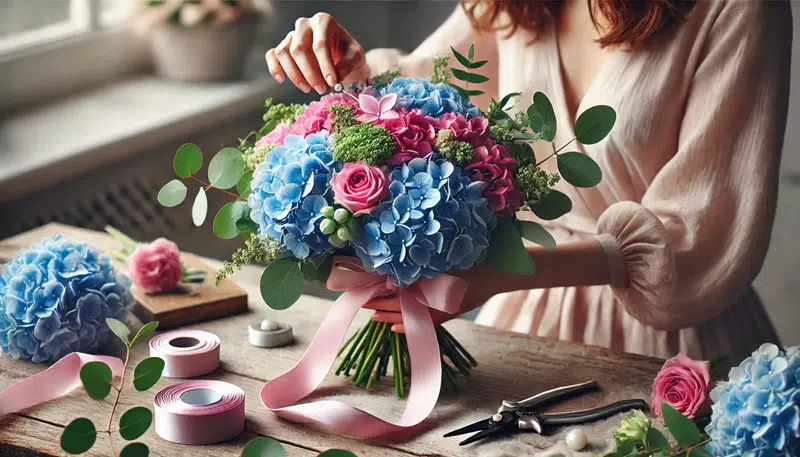 Source: hydrangealibrary.com; Author: AI
Source: hydrangealibrary.com; Author: AI
1. Binding the Stems
After arranging your hydrangeas and any complementary flowers or foliage, it's crucial to bind the stems securely:
- Use Floral Tape: Wrap floral tape around the stems just below the blooms, ensuring all stems are held firmly together. This provides a stable base for the bouquet.
- Maintain Stem Alignment: Ensure the stems are aligned and not crossing over each other, which helps in creating a neat and manageable handle.
2. Trimming the Stems
Properly trimmed stems contribute to the bouquet's appearance and ease of handling:
- Determine the Desired Length: Decide on the length of the stems based on the vase size or the intended presentation style.
- Cut at an Angle: Using sharp floral scissors or a knife, trim the stems at a 45-degree angle. This facilitates better water absorption if the bouquet will be placed in a vase.
3. Wrapping the Stems with Ribbon
Adding a ribbon wrap enhances the bouquet's aesthetic and conceals the binding point:
- Choose Appropriate Ribbon: Select a ribbon that complements the colour scheme of the bouquet and suits the occasion. Silk or satin ribbons are popular choices for their elegant appearance.
- Secure the Starting Point: Attach the ribbon just above the floral tape by inserting a corsage pin through the ribbon and into the stems, ensuring it's secure.
- Wrap the Stems: Tightly and evenly wrap the ribbon down the length of the stems, covering the floral tape completely. For a polished look, overlap each layer slightly.
- Secure the End: Once you've covered the desired length, trim the ribbon and secure the end with another corsage pin, inserting it at an angle to ensure it doesn't protrude.
4. Adding Decorative Elements
Enhance the bouquet's visual appeal with additional decorative touches:
- Ribbon Tails or Bows: Leave some length of ribbon at the end to create flowing tails or tie a decorative bow for added elegance.
- Embellishments: Consider adding small decorative elements like pearl pins or lace overlays to match the bouquet's theme.
5. Preserving the Bouquet's Freshness
To maintain the hydrangeas' vibrancy:
- Hydrate the Stems: If not displaying the bouquet immediately, place the stems in water to keep them hydrated.
- Store Appropriately: Keep the bouquet in a cool environment, away from direct sunlight and heat sources, until it's time for presentation.
By meticulously securing and finishing your hydrangea bouquet, you ensure it remains beautiful and intact for your event, reflecting a professional touch.
Caring for Your Bouquet
Ensuring the longevity and vibrancy of your hydrangea bouquet requires attentive care. By following these detailed steps, you can maintain the freshness and beauty of your arrangement for an extended period.
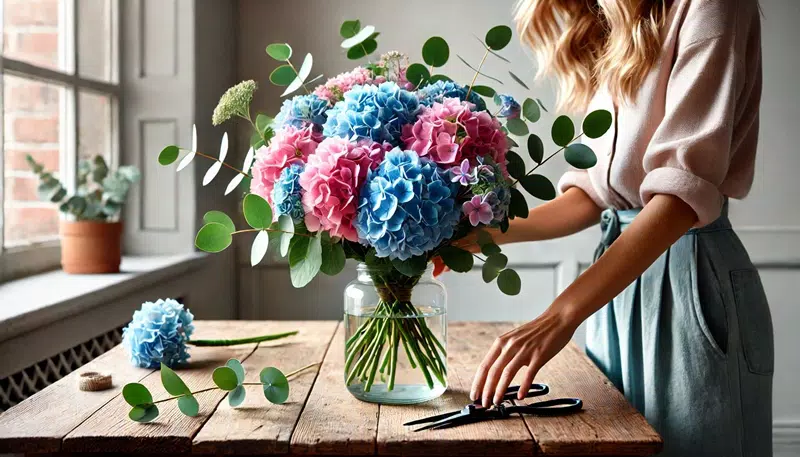 Source: hydrangealibrary.com; Author: AI
Source: hydrangealibrary.com; Author: AI
1. Immediate Post-Arrangement Care
After arranging your hydrangea bouquet, place it in a clean vase filled with fresh, cool water. Ensure that no leaves are submerged in the water, as this can promote bacterial growth.
2. Regular Water Maintenance
Hydrangeas are known for their high water intake. Check the water level daily and replenish as needed to keep the stems adequately hydrated. Changing the water every two days helps prevent bacterial buildup, which can impede water absorption.
3. Re-Cutting Stems
Every two to three days, remove the bouquet from the vase and re-cut the stems at a 45-degree angle. This practice enhances water uptake by preventing air pockets from forming in the stems.
4. Optimal Placement
Position your bouquet in a cool environment, away from direct sunlight, heating vents, and drafts. Exposure to excessive heat or sunlight can cause the blooms to wilt prematurely.
5. Use of Floral Preservatives
Adding a floral preservative to the vase water can provide essential nutrients and inhibit bacterial growth, thereby extending the life of your hydrangea bouquet.
6. Reviving Wilted Blooms
If you notice the hydrangea blooms starting to wilt, submerge the entire flower heads in a basin of cool water for approximately 30 minutes. This method allows the flowers to absorb water through both the petals and stems, revitalising their appearance.
7. Avoiding Ethylene Exposure
Keep your bouquet away from ripening fruits, as they emit ethylene gas, which can accelerate the ageing of flowers.
By diligently following these care practices, you can enjoy the splendour of your hydrangea bouquet for an extended period, bringing lasting beauty to your space.
Seasonal Hydrangea Bouquets: Best Ideas for Every Season
Hydrangeas are versatile flowers that can be incorporated into stunning bouquets throughout the year. By pairing them with seasonal blooms and foliage, you can create arrangements that reflect the unique beauty of each season.
Spring: Embracing Freshness and Renewal
In spring, combine hydrangeas with early bloomers to capture the season's freshness:
- Tulips: Their sleek petals contrast beautifully with the fullness of hydrangeas.
- Daffodils: Add a cheerful yellow hue, symbolising new beginnings.
- Ranunculus: Their layered petals complement hydrangeas' texture.
Incorporate fresh greenery like ferns or eucalyptus to enhance the bouquet's lushness.
Summer: Celebrating Vibrancy and Abundance
Summer allows for bold and colourful combinations:
- Roses: Classic and available in various colours to match your palette.
- Peonies: Their large, fragrant blooms pair well with hydrangeas.
- Delphiniums: Introduce height and a spectrum of blues and purples.
Adding foliage like ivy or lemon leaf can provide depth and contrast.
Autumn: Reflecting Warmth and Richness
In autumn, opt for deeper tones and textured elements:
- Chrysanthemums: Offer a variety of shapes and rich colours.
- Sunflowers: Introduce a rustic charm and vibrant yellow.
- Hypericum Berries: Add texture and autumnal hues.
Incorporate dried elements like wheat stalks or pampas grass for an added seasonal touch.
Winter: Showcasing Elegance and Simplicity
Winter bouquets can exude elegance with a minimalist approach:
- Amaryllis: Their striking blooms make a bold statement.
- Evergreen Sprigs: Add a festive and aromatic element.
- White Roses: Symbolise purity and complement winter themes.
Accents like pinecones or silver brunia can enhance the wintery feel.
By thoughtfully selecting complementary flowers and foliage, hydrangea bouquets can be tailored to reflect the essence of each season, bringing natural beauty into any setting year-round.
Choosing the Right Vase for Your Hydrangea Arrangement
Selecting an appropriate vase is essential to showcase the beauty of hydrangeas and ensure the stability of your arrangement. The vase's size, shape, and material all play pivotal roles in complementing the voluminous blooms of hydrangeas.
1. Consider the Size and Shape
Hydrangeas possess large, heavy blooms that require adequate support:
- Wide-Mouthed Vases: A vase with a broad opening allows the hydrangea heads to spread naturally, accommodating their expansive size.
- Sturdy Base: A stable base prevents the arrangement from toppling over due to the weight of the blooms.
- Appropriate Height: The vase should be tall enough to support the length of the stems, preventing drooping.
2. Material Matters
The material of the vase influences both aesthetics and functionality:
- Glass Vases: Transparent glass vases allow you to monitor water levels and cleanliness, ensuring the hydrangeas remain hydrated and fresh.
- Ceramic Vases: Ceramic containers offer elegance and come in various shapes, sizes, and colours to match different hydrangea types.
- Metal Vases: For a modern touch, metal vases provide a chic contrast to the delicate hydrangea blooms.
3. Matching Vase Style with Arrangement
Aligning the vase's style with your arrangement enhances visual harmony:
- Traditional Arrangements: Classic vase shapes, such as urns or flared designs, complement traditional hydrangea bouquets.
- Contemporary Arrangements: Sleek, minimalist vases with clean lines suit modern floral designs.
- Rustic Arrangements: Mason jars or vintage pitchers add a charming, rustic feel to the display.
4. Practical Considerations
Beyond aesthetics, consider the following practical aspects:
- Ease of Cleaning: Vases with wider openings are easier to clean, preventing bacterial buildup that can shorten the lifespan of your hydrangeas.
- Water Capacity: Hydrangeas are known for their high water intake; ensure the vase holds sufficient water to keep the stems submerged.
- Stem Support: Using a vase that narrows at the neck can help support the stems and keep the blooms upright.
By thoughtfully selecting a vase that complements both the aesthetic and practical needs of your hydrangea arrangement, you can create a stunning display that enhances the beauty of these lush blooms.
DIY Floral Preservatives: How to Keep Your Bouquets Fresh Longer
Extending the life of your floral arrangements can be achieved by using homemade preservatives. These solutions nourish the flowers and inhibit bacterial growth, ensuring your bouquets remain vibrant.
Understanding Floral Preservatives
Floral preservatives typically contain three key components:
- Sugar: Provides essential nutrients to sustain the flowers.
- Acidifier: Lowers the pH of the water, enhancing water uptake.
- Antimicrobial Agent: Prevents bacterial and fungal growth that can block water absorption.
Homemade Floral Preservative Recipes
Here are some effective DIY solutions:
- Recipe 1: Dissolve 1 tablespoon of sugar and ¼ teaspoon of household bleach in 1 quart of warm water.
- Recipe 2: Mix 2 tablespoons of sugar with 2 tablespoons of lemon juice or white vinegar in 1 quart of warm water.
- Recipe 3: Combine 2 tablespoons of white vinegar, 2 tablespoons of sugar, and ½ teaspoon of household bleach in 1 quart of warm water.
Ensure the sugar is fully dissolved and allow the solution to cool before adding your flowers.
Application Tips
- Clean Vase: Always use a thoroughly cleaned vase to minimise bacterial contamination.
- Fresh Solution: Replace the preservative solution every two days to maintain its effectiveness.
- Stem Maintenance: Re-cut the flower stems at a 45-degree angle under running water before placing them in the preservative solution to enhance water uptake.
Additional Considerations
- Water Temperature: Use warm water to help dissolve the ingredients and facilitate better absorption by the flowers.
- Environmental Factors: Keep the bouquet away from direct sunlight, heat sources, and ripening fruits, as ethylene gas can accelerate wilting.
By utilising these homemade floral preservatives and following proper care practices, you can significantly prolong the freshness and beauty of your bouquets.
Hydrangea Colour Changes: How to Adjust Bloom Colours Naturally
Hydrangeas are unique among flowering plants due to their ability to change bloom colours based on soil conditions. By understanding and manipulating these factors, gardeners can naturally alter hydrangea hues to achieve desired aesthetic effects.
Understanding Hydrangea Colour Variations
The primary determinant of hydrangea bloom colour is the soil's pH level:
- Acidic Soils (pH below 6): Tend to produce blue flowers.
- Neutral Soils (pH 6 to 7): Often result in purple blooms.
- Alkaline Soils (pH above 7): Typically yield pink flowers.
This colour change is influenced by the availability of aluminium ions in the soil, which hydrangeas absorb more readily in acidic conditions, leading to blue pigmentation.
Testing Soil pH
Before attempting to alter bloom colours, it's essential to determine your soil's current pH:
- Purchase a soil pH testing kit from a reputable garden centre.
- Collect samples from the area around your hydrangeas.
- Follow the kit's instructions to ascertain the pH level.
Regular testing ensures that any amendments achieve the desired pH balance.
Adjusting Soil pH to Change Bloom Colour
To modify hydrangea bloom colours, consider the following natural methods:
- For Blue Blooms:
- Incorporate organic materials like coffee grounds, fruit peels, or pine needles to increase soil acidity.
- Apply aluminium sulphate cautiously, as excessive use can harm plants.
- For Pink Blooms:
- Add garden lime or wood ash to raise soil alkalinity.
- Ensure gradual pH adjustments to prevent plant stress.
It's crucial to implement changes slowly and monitor soil pH regularly to maintain plant health.
Considerations and Limitations
- Not all hydrangea species exhibit colour changes; for instance, white hydrangeas typically remain unaffected by soil pH.
- Environmental factors, such as climate and rainfall, can influence soil pH and, consequently, bloom colour.
- Achieving significant colour changes may require time and consistent soil management.
By understanding the relationship between soil pH and hydrangea pigmentation, gardeners can naturally adjust bloom colours, enhancing the visual appeal of their gardens.
Arranging Hydrangeas for Special Occasions: Weddings, Birthdays, and More
Hydrangeas, with their lush blooms and diverse colours, are a popular choice for various events. Their versatility allows them to be the focal point or a complementary element in floral arrangements. This guide explores how to incorporate hydrangeas into different occasions, ensuring they enhance the event's aesthetic.
Weddings
Hydrangeas are favoured in weddings for their romantic appeal and adaptability.
- Bridal Bouquets: Hydrangeas can be used alone for a classic look or combined with roses and peonies for added texture and depth.
- Ceremony Décor: Use hydrangeas in altar arrangements, pew decorations, or as part of a floral arch to create a cohesive theme.
- Reception Centerpieces: Their voluminous nature means fewer stems are needed to create full, impactful centerpieces.
Birthdays
For birthday celebrations, hydrangeas add elegance and freshness.
- Table Arrangements: Mix hydrangeas with seasonal flowers to create vibrant centerpieces that reflect the celebrant's personality.
- Themed Décor: Choose hydrangea colours that align with the party's theme or the recipient's favourite hues.
- Gift Bouquets: A bouquet featuring hydrangeas makes for a thoughtful and beautiful birthday gift.
Anniversaries
Commemorate milestones with hydrangeas to symbolise gratitude and heartfelt emotion.
- Romantic Bouquets: Combine hydrangeas with roses to create a bouquet that signifies enduring love.
- Home Décor: Place hydrangea arrangements in key areas of the home to set a celebratory mood.
- Event Styling: Use hydrangeas in event décor to create a cohesive and elegant atmosphere.
Corporate Events
Hydrangeas can elevate the aesthetic of corporate functions, adding a touch of sophistication.
- Reception Areas: Place hydrangea arrangements at entry points to create a welcoming environment.
- Table Centerpieces: Use neutral-coloured hydrangeas to maintain a professional yet stylish look.
- Brand Alignment: Select hydrangea colours that match the company's branding for a cohesive appearance.
Funerals
In memorial services, hydrangeas convey heartfelt emotions and respect.
- Sympathy Bouquets: Hydrangeas can be used in sympathy arrangements to express condolences.
- Altar Arrangements: Their serene appearance makes them suitable for altar displays.
- Graveside Tributes: Hydrangea wreaths or sprays can serve as respectful tributes.
By thoughtfully incorporating hydrangeas into various events, you can enhance the ambiance and convey appropriate sentiments, making each occasion memorable.
By following these steps, you can create a stunning hydrangea bouquet that brightens any space and serves as a delightful centrepiece.
About the Author

Richard Seres-Nagy is a passionate gardener with over 20 years of experience in hydrangea care. He founded Hydrangea Library to share expert advice, step-by-step guides, and practical tips for fellow gardening enthusiasts.
Read More
